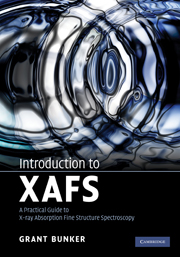Book contents
- Frontmatter
- Contents
- Preface
- 1 Introduction
- 2 Basic physics of X-ray absorption and scattering
- 3 Experimental
- 4 Theory
- 5 Data analysis
- 6 Related techniques and conclusion
- Appendix 1 Introduction to Fourier transforms in EXAFS
- Appendix 2 Cumulants in EXAFS
- Appendix 3 Optimizing X-ray filters
- Appendix 4 Reference spectra
- Appendix 5 X-ray tables
- References
- Index
Appendix 4 - Reference spectra
Published online by Cambridge University Press: 25 January 2011
- Frontmatter
- Contents
- Preface
- 1 Introduction
- 2 Basic physics of X-ray absorption and scattering
- 3 Experimental
- 4 Theory
- 5 Data analysis
- 6 Related techniques and conclusion
- Appendix 1 Introduction to Fourier transforms in EXAFS
- Appendix 2 Cumulants in EXAFS
- Appendix 3 Optimizing X-ray filters
- Appendix 4 Reference spectra
- Appendix 5 X-ray tables
- References
- Index
Summary
There is perennial interest in reference XAFS spectra. This appendix contains a small sample of µ data taken by the author and collaborators. Preedge fits are removed to improve visibility, but that is all.
The first three spectra are from study of multiple scattering in gases. A Si(111) monochromator was used on a bend magnet beamline (X9) at NSLS. This study permitted isolation of the Cl multiple scattering signal in molecular gases simply by taking linear combinations of raw spectra. Weak backscattering from hydrogen was also noted. The triangle path scattering is evident right above the “white line”; similar features are seen in ZnS4 tetrahedral sites such as are present in ZnS and various enzymes, such as Aspartate Transcarbamoylase. The GeCl4 spectrum contains single scattering plus multiple scattering among the Cl; GeH3Cl contains mostly single scattering from the Cl and weak scattering from H, (the weak multiple scattering between the central atom and the Cl and multiple scattering among the hydrogens are neglected). GeH4 principally has only weak backscattering from the hydrogens.
The other spectra were taken with a Si(220) monochromator and an 18 KG wiggler at SSRL. The next three spectra are KMnO4 at 80K, 160K, 300K sample temperature. Note the temperature dependence of the high frequency structure at the edge. This is due to single scattering contributions from non-nearest neighbor atoms, which are loosely bound, and therefore have large temperature dependent σ2.
- Type
- Chapter
- Information
- Introduction to XAFSA Practical Guide to X-ray Absorption Fine Structure Spectroscopy, pp. 232 - 240Publisher: Cambridge University PressPrint publication year: 2010

